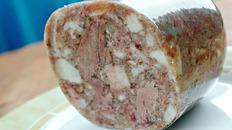Meats and Sausages
All Trimmings Head Cheese (Salceson Podrobowy)
Offal meat and blood make this Polish head cheese. This head cheese recipe should be of interest to people who raise their own animals as it incorporates meats which are usually not served on a dinner plate.
| Meats | Metric | US |
|---|---|---|
| Lungs, spleens, udders, pork tripe, veal casings, veal pork stomachs, boiled: beef, veal or lamb head meat, boiled bone meat (unsalted), beef and veal lips, pork skins, pork and beef trimmings (unsalted), pork, beef, veal or lamb brains | 750 g | 1.65 lb |
| Blood | 100 g | 3.52 oz |
| Jowls | 150 g | 5.29 oz |
Ingredients per 1000g (1 kg) of meat
| salt | 18 g | 3 tsp |
| marjoram | 2.0 g | 1 tsp |
| pepper | 2.0 g | 1 tsp |
| allspice | 1.0 g | 1/2 tsp |
| onion, fresh | 30 g | 2 Tbsp |
Instructions
- Except spleen, brains and blood, poach other meats in a small amount of water:
- lungs, tripe and bloody meats at 85°C (185°F) until soft heads, skins, lips, udders, tripe and pork stomachs at 95°C (203°F) until soft
- jowls at 85°C (185°F) until semi-soft
- After poaching remove gristle from lungs and meat from bones. Spread meats apart on a flat surface to cool.
- Cut jowls into 8-10 mm (3-4”) cubes. Grind udders and lungs through 5 mm plate. Grind raw spleen ground through 3 mm plate. Grind all other meats through 3 mm plate.
- Mix all ground meats with spices and blood.
- Stuffing materials: veal bladders or 60 mm (2¼”) synthetic casings. Butcher’s twine. Stuff casings loosely and sew the bladder ends with twine. Tie the synthetic casing ends with twine.
- Poach bladders at 82°C (180°F) for 78-80 min (depending on size) and synthetic casings at 78-80°C (172-176°F) until the internal temperature of the meat reaches 68-70°C (154-158°F). Remove air with a needle from pieces that swim up to the surface.
- Spread head cheeses on a flat surface at 2-6°C (35-43°F) and let the steam out. Then flatten them with weight and cool them to below 6°C (43°F). Do not flatten synthetic casings. If there is no proper cooler available, cool them down to less than 12°C (53°F).
- After cooling clean head cheeses of any fat and aspic that accumulated on the surface, even them out and cut off excess twine.
Notes
Lips and skins weight total not to exceed 30% (300 g per 1 kg meat total). Lamb meat total not to exceed 10%. In case that meats are already partly salted this fact must be taken under consideration when adding salt during production.
The natural pepper may be substituted with a double amount of herbal pepper (white mustard seed, caraway, marjoram, chili, hot and sweet paprika, bay leaf).
Veal bladder-flattened irregular disk, 18 x 12 x 7 cm (7 x 5 x 3”), synthetic casings links about 20 cm (8”) long.


















